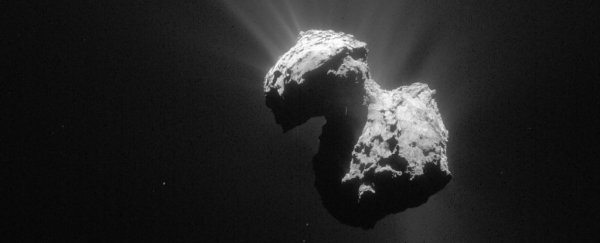A halo of oxygen molecules has been found on the comet 67P/Churyumov-Gerasimenko, and the researchers behind the discovery aren't quite sure why it's there. But there's a good chance the oxygen was present before or during the formation of the comet, and if that's true, we need to rethink current models of how the Solar System came to be.
"This is the first comet that we've found which has molecular oxygen," lead researcher André Bieler from the University of Michigan told the ABC. "The detection of molecular oxygen is new and very surprising. This was a very strong signal indicating that we found a lot of it."
The molecular oxygen (O2) was detected by a mass spectrometer onboard the European Space Agency's Rosetta spacecraft as it orbited the comet between September 2014 and March 2015. It was found alongside a bunch of other chemicals in the gas halo, including water vapour, carbon monoxide, and carbon dioxide. Bieler and his colleagues estimate that the oxygen makes up about 3.8 percent of the mysterious comet cloud.
The fact that it took them more than a year to report the discovery of the first known molecular oxygen on a comet might sound a bit fishy, but the researchers say they held off for so long because they had to make sure that it wasn't the result of some kind of contamination or error. "We all went a little bit into denial," said Kathrin Altwegg from the University of Bern in Switzerland at a news conference this week.
"No-one expected this to happen so we didn't want to publish anything right away," Bieler told Stauart Gary at the ABC. "We decided to keep monitoring this molecular oxygen signature until we were sure we understood what was happening."
The reason for all this disbelief is that O2 is usually very quick to react to other chemicals, just like the ones swimming around it in 67P's 'coma' - a halo of gas, dust, and ice that forms as a comet nears the Sun on an elliptical orbit. And there were only two realistic scenarios to explain why it was there - it was being produced on the surface of the comet during the period of observation, or it's been there since the comet was first formed.
During the seven months of observation, the comet drew as close to the Sun as its orbit allows, and all that extra heat energy sent it into a particularly 'active' state, as its surface ice was condensed into gas. Bieler and his colleagues hypothesised that at the same time, the energetic particles spewing forth from the Sun were splitting apart the water molecules to create hydrogen and oxygen.
This is how the only other known cases of molecular oxygen in the Solar System - on the icy moons of Jupiter and Saturn - are believed to have formed. But the researchers ruled out this possibility when they compared the ratio of molecular oxygen to water on the two faces of the comet - the one facing the Sun, and the one facing away - and found that it remained consistent.
The only other possibility is that the O2 had been trapped inside the comet and was being released as its host shed its surface material during its close solar encounter. "Comets lose between one and 10 metres of their surface material during each orbit around the Sun," Bieler told the ABC. "Because Comet 67P has been around for quite a while, we estimate that it's lost hundreds of metres of its surface material."
The team now argues that the O2 was embedded in the comet as it formed, at the birth of the Solar System some 4.6 billion years ago. But there's one problem with this hypothesis, and it's a big one - the aforementioned reactiveness of molecular oxygen. Rachel Feltman explains at The Washington Post:
"No current models of the Solar System's formation would allow for molecular oxygen to get locked away inside a comet. Oxygen is highly reactive, so it's always been assumed that any molecular oxygen present would bond with the abundantly available hydrogen. The researchers were shocked to see that oxygen could 'survive' in its molecular form for billions of years."
It's possible that we've just estimated the temperature conditions at the time of the Solar System's birth incorrectly - perhaps things were warmer than we thought. The team is now going to look at other comets to see if they can find evidence of more O2.
The study has been published in Nature.
